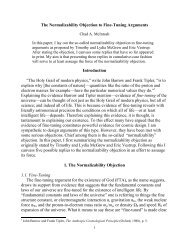Theism and Explanation - Appeared-to-Blogly
Theism and Explanation - Appeared-to-Blogly
Theism and Explanation - Appeared-to-Blogly
You also want an ePaper? Increase the reach of your titles
YUMPU automatically turns print PDFs into web optimized ePapers that Google loves.
Successful Theistic <strong>Explanation</strong>s 131<br />
just which intention lies behind each creative act (7.1.1), but he implicitly<br />
recognises that different intentions are required. And in explaining, for<br />
instance, the existence of animals, Swinburne takes for granted the existence<br />
of a universe. Only if we subsume all of these intentions under the<br />
catch-all category of “reasons God would have <strong>to</strong> do x”—a strategy I have<br />
already argued is unhelpful—would this appear <strong>to</strong> be one explanation.<br />
In a word, Mackie is right. While positing the existence of an unembodied<br />
agent might be warranted, if that hypothesis possessed other explana<strong>to</strong>ry<br />
virtues, the fact that it posits an otherwise unknown kind of mechanism<br />
counts against it. The theist may not neglect this fact.<br />
7.3 PAST EXPLANATORY SUCCESS<br />
There is another explana<strong>to</strong>ry virtue that could be classed under background<br />
knowledge, but which is signifi cant enough <strong>to</strong> be listed separately.<br />
It is the previous explana<strong>to</strong>ry success (or lack of it) of the kind of hypothesis<br />
that is on offer. Some care is required here. I am not speaking of what<br />
we might call the “track record”of the same hypothesis. For given that a<br />
hypothesis can be corroborated by known facts (7.1.2), considerations of<br />
past explana<strong>to</strong>ry success would come under the heading of corroboration.<br />
But hypotheses cannot be fully unders<strong>to</strong>od, nor should they be evaluated,<br />
in isolation from one another. Any particular hypothesis can be seen as<br />
part of a research programme or a research tradition, which unites a series<br />
of proposed explanations sharing certain common assumptions. And we<br />
can include under background knowledge the past successes or failures of<br />
the research programme <strong>to</strong> which our hypothesis belongs.<br />
It is true that <strong>to</strong> speak of “research programmes” raises some diffi cult<br />
issues. For any particular classifi cation of hypotheses in<strong>to</strong> research programmes<br />
can be contested. What we may regard as distinct research programmes<br />
often overlap: they share common assumptions. 62 And within a<br />
single research programme there may exist fi erce disputes about the assumptions<br />
being employed. 63 But I argued in Chapter 1 that we can distinguish<br />
the naturalistic research programme of the modern sciences—which proceeds<br />
as if there were no God—from the tradition of proposed theistic<br />
explanations. Insofar as they sometimes seek <strong>to</strong> offer mutually exclusive<br />
explanations of the same phenomena (4.3.3.2), these two programmes are<br />
in competition.<br />
Not only are they in competition, but a comparison of their track records<br />
will count against theism. For the naturalistic research programme of the<br />
modern sciences has been stunningly successful since its inception in the seventeenth<br />
century. Again <strong>and</strong> again, it has shown that postulating the existence<br />
of a deity is not required in order <strong>to</strong> explain the phenomena. Sir Isaac New<strong>to</strong>n<br />
(1642–1727) still required God <strong>to</strong> fi ne-tune the mechanics of his solar system,<br />
but by the time of Pierre Simon de Laplace (1749–1827), the astronomer



